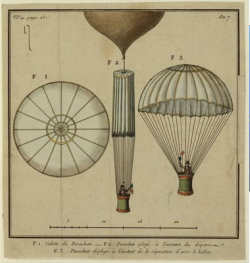A Long Way Down: Designing Parachutes

The Elementary students studied astronomy and aerospace engineering and the design of parachutes. This study introduced the field of aerospace engineering by guiding students to explore how engineers use their knowledge of science, math, astronomy, and their creativity to design and test technologies that solve problems related to extraterrestrial (non Earth) environments. Hands on activities, discussions, and readings were used to introduce students to the Engineering Design Process, the work of aerospace engineers, and other engineering and technology concepts appropriate for elementary students.
Background

Aerospace engineering began as two distinct fields: aeronautical engineering and astronautical engineering. Aeronautical engineering focused on all aspects of flight and travel within the Earth's atmosphere. Astronautical engineering focused on flight and travel outside of our atmosphere. As technology advanced and single vehicles (such as the space shuttle) were designed to cross from Earth's atmosphere into space, these two fields merged into what is now known as aerospace engineering.
Flight, both inside and outside of our atmosphere, is a complicated undertaking. Because of this, aerospace engineers often specialize in one of many areas, such as propulsion, aerodynamics, fluids, flight mechanics, heat transfer, cost analysis, reliability, survivability, maintainability, operations research, marketing, or airspace management. Additionally, engineers often work on teams with scientists, other engineers and mathematicians, computer scientists, and medical personnel.
Aerospace engineers often have the challenging task of designing technologies that will be used in environments vastly different from the environment here on Earth; therefore making the data from testing on Earth unreliable. For example, when an aerospace engineer designs a spacecraft to travel to Mars, he or she cannot test it in an actual Martian environment without a large investment of time and money. For this reason (along with others) models and simulations are extremely important tools for aerospace engineers.
Aerospace engineers also have a unique perspective regarding the maintenance of the technologies they design due to the environments in which they are often used. When most technologies break down, an expert can be called in with the appropriate tools and knowledge to fix the equipment. However, in space flight, crews need to be able to fix problems using only the materials available in the craft - they cannot get spare parts or special tools. In the case of unmanned spacecraft, the problem must often be solved remotely from a control station on Earth. The remote nature of aerospace engineering, along with the potential risk to human lives, means that aerospace engineers must always think about the possibility of a worst case scenario becoming a reality.
Aerospace engineers are often faced with demanding criteria and unique challenges when designing technologies. They are part of the team behind all of the space shuttles, satellites, and probes that have led to new and fascinating discoveries about our universe. Without them, space exploration as we know it would be an impossibility.
Flight, both inside and outside of our atmosphere, is a complicated undertaking. Because of this, aerospace engineers often specialize in one of many areas, such as propulsion, aerodynamics, fluids, flight mechanics, heat transfer, cost analysis, reliability, survivability, maintainability, operations research, marketing, or airspace management. Additionally, engineers often work on teams with scientists, other engineers and mathematicians, computer scientists, and medical personnel.
Aerospace engineers often have the challenging task of designing technologies that will be used in environments vastly different from the environment here on Earth; therefore making the data from testing on Earth unreliable. For example, when an aerospace engineer designs a spacecraft to travel to Mars, he or she cannot test it in an actual Martian environment without a large investment of time and money. For this reason (along with others) models and simulations are extremely important tools for aerospace engineers.
Aerospace engineers also have a unique perspective regarding the maintenance of the technologies they design due to the environments in which they are often used. When most technologies break down, an expert can be called in with the appropriate tools and knowledge to fix the equipment. However, in space flight, crews need to be able to fix problems using only the materials available in the craft - they cannot get spare parts or special tools. In the case of unmanned spacecraft, the problem must often be solved remotely from a control station on Earth. The remote nature of aerospace engineering, along with the potential risk to human lives, means that aerospace engineers must always think about the possibility of a worst case scenario becoming a reality.
Aerospace engineers are often faced with demanding criteria and unique challenges when designing technologies. They are part of the team behind all of the space shuttles, satellites, and probes that have led to new and fascinating discoveries about our universe. Without them, space exploration as we know it would be an impossibility.
